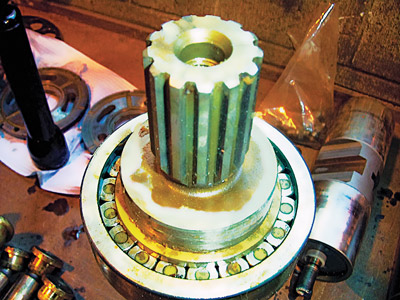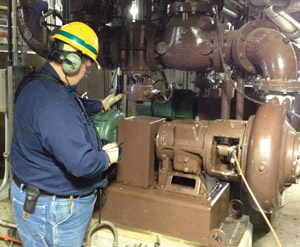Ask the Experts
“What could be the reason for a hydraulic pump failure and how can we prevent such failures in the future?”
 A hydraulic pump failure can be caused by a number of factors. There are several different types of pumps available on the market, and each can have its own specifc failure mode. Of course, certain failure modes are common to all types of pumps. Some of these failures can be caused by poor system design, using low-quality fluids and/or poor contamination control.
A hydraulic pump failure can be caused by a number of factors. There are several different types of pumps available on the market, and each can have its own specifc failure mode. Of course, certain failure modes are common to all types of pumps. Some of these failures can be caused by poor system design, using low-quality fluids and/or poor contamination control.
The best way to prevent future failures is to ensure that you are using quality hydraulic fluids. Keep in mind that the fluid is the single most important component of a hydraulic system, so always use high-quality hydraulic fluids with the correct viscosity.
Hydraulic fluids should also be kept clean, cool and dry. This is very important. One of the ways you can do this is through quality fltration. Filters should be selected only if they achieve the target cleanliness levels that have been set for the fluid in the system. Also, use quality flters in locations that assure the required protection and upgrade the flters when necessary.
In addition, consider the possibility of using offline flters, because the cost of removing dirt is often much less in an offline mode than trying to do everything in a pressure-line flter location on the hydraulic system.
It is estimated that between 70 to 80 percent of hydraulic system failures are from contamination, with particle contamination making up the largest portion. Therefore, it is best practice to regularly perform oil analysis with particle counts.
Remember, the hydraulic pump is generally the most expensive component on a hydraulic system. It has the highest reliability risk, the highest contaminant sensitivity risk and the ability to cause chain-reaction failures. In other words, when the pump begins to fail, it starts to kick out debris into a debris feld downstream of the pump. If there is not a good flter downstream, this debris moves on to other components like valves and actuators, and can lead to damage in those components as well.
Be wary of quick-fx solutions like switching to costly synthetics and expensive fltration systems. Instead, provide solutions to the problems that exist. It is critical to set the proper cleanliness and dryness targets and to develop contamination control procedures that will allow you to meet those targets. By doing so, you should greatly reduce and possibly eliminate your pump failures.
“What does spike energy indicate?”
 Spike energy is a term more associated with vibration analysis than with any of the other predictive maintenance technologies. Basically, as a machine begins to fail and the interior working surfaces degrade, varying levels of vibration emanate from the bearing while wear progresses. Spike energy is the high frequency levels of the vibration being produced by the “ringing” of the internal surfaces rubbing together.
Spike energy is a term more associated with vibration analysis than with any of the other predictive maintenance technologies. Basically, as a machine begins to fail and the interior working surfaces degrade, varying levels of vibration emanate from the bearing while wear progresses. Spike energy is the high frequency levels of the vibration being produced by the “ringing” of the internal surfaces rubbing together.
As with any predictive technology, the power is in the vigilant monitoring of the equipment. To get the maximum return, you should establish a baseline when the machine is frst put into service. This will serve as a point against which all future results will be compared.
As wear continues, the level of vibration or “noise” will trend upward. By understanding the natural frequency of the metals that are degrading, you can begin to make calculated guesses at the amount of wear as well as the relative life remaining in the component.
This can be related to trending wear debris with oil analysis. When a machine is put into service, the frst sample is usually the cleanest in terms of wear debris. While contaminants such as dirt and water are introduced into the system, the surfaces begin to degrade and produce more wear debris. By tracking not only the amount of wear debris but also the rate of generation of these particles, you begin to get a better picture of the degradation rate and the machine’s overall health.
With oil analysis, you have the added beneft of looking at wear debris shapes to monitor wear and diagnose the root cause. It is harder to do this when simply using vibration.
Consistency is paramount to catch any incipient machine failures and to accurately predict machine health. If you are using vibration to monitor wear generation or a machine’s failure modes, you must capture the vibration results from the same spot on the equipment each time it is to be monitored. The same is true for oil analysis. To trend properly, you must sample from the same location using the same procedure each time a sample is extracted.
In a world-class facility, you wouldn’t simply rely on a single technology to accurately predict the wear and failure of machine parts. Vibration is a powerful tool, as is oil analysis. When you merge the two together, you get a much clearer picture of what is happening inside the machine and can better predict when a failure might occur. Be sure to integrate all of your predictive maintenance systems for maximum reliability.
